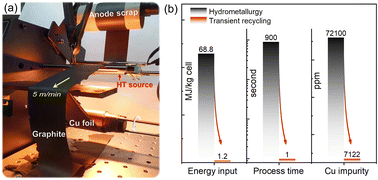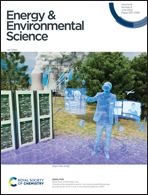Transient and dry recycling of battery materials with negligible carbon footprint and roll-to-roll scalability†
Abstract
Battery recycling becomes increasingly important due to the ubiquitous application of Li-ion batteries that challenges both critical material supply and environmental sustainability. Compared with pyro- and hydro-metallurgy, direct recycling recovers high-purity materials and has less environmental impact. However, most direct recycling methods are complex with a low yield and very limited scalability. Herein, we report transient recycling of battery materials with >97% recovery ratio and ∼100% intact metal foil by shock-type heating (1500 °C, 1 s) or continuously rolled-over heating (∼5 m min−1), thus demonstrating extremely high energy, time, and material efficiencies. Furthermore, thermal simulation and in situ mass spectroscopy reveal that the temperature distribution is spatially uniform in the electrode and the binder network can be effectively decomposed into gases and amorphous carbon coatings. The ultra-short calcination time brings a minimum impact to battery materials and thus benefits simple and effective regeneration. We demonstrated in general the recycling of anodes from different companies, various cathodes, and particularly battery scraps which can be recycled in a roll-to-roll device continuously and automatically (Movie S1, ESI). Compared with hydrometallurgy, EverBatt analysis reveals that our transient battery recycling has a significantly lower energy and carbon footprint (∼50× reduction), near-zero waste generation, and much higher profits (even 4.78 $ per kg for the often-unprofitable anode), thus making it practical for direct recycling of battery materials with outstanding efficiency, sustainability, and scalability.



 Please wait while we load your content...
Please wait while we load your content...